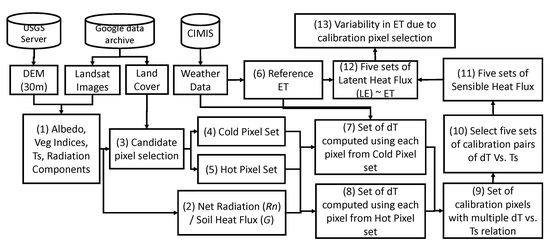Estimating Calibration Variability in Evapotranspiration Derived from a Satellite-Based Energy Balance Model
Abstract
:1. Introduction
2. Materials and Methods
2.1. Study Area
2.1.1. Measured ET Data
2.1.2. Landsat Images
2.1.3. Weather Data
2.1.4. Land Cover Data
2.2. METRIC Model
2.3. Google Earth Engine for METRIC
2.4. Selection of Calibration Pixels
2.4.1. Hot and Cold Pixel Set Identification
2.4.2. Determination of the dT vs. Ts Relationship from Selected Candidate Pixels
2.5. Determination of Daily ET
3. Results
3.1. Properties of Candidate Calibration Pixels
3.2. Effect of Calibration Pixel Selection on ET
3.3. Evaluation of Daily ET Estimates from Different Calibration Sets
4. Discussion
4.1. Candidate Calibration Pixel Properties
4.2. Model Performance
4.3. Use and Limitations of This Approach to Estimate Variability in METRIC Due to Calibration Pixel Selection
5. Conclusions
- // Load a Landsat 8 ImageCollection for a single path-row.
- var collection = ee.ImageCollection(‘LANDSAT/LC08/C01/T1_TOA’)
- .filter(ee.Filter.eq(‘WRS_PATH’, 44))
- .filter(ee.Filter.eq(‘WRS_ROW’, 34))
- .filterDate(‘2015-06-25’, ‘2015-07-01’);
- // Get the first image from the image collection
- var img = ee.Image(collection.first());
- // Define a function to compute NDVI.
- var NDVI = function(image) {
- return image.expression(‘float(b(“B5”) − b(“B4”)) / (b(“B5”) + b(“B4”))’);
- };
- // Use NDVI function
- NDVI_img = NDVI(img);
- // Display the NDVI image
- Map.addLayer (NDVI_img, {min: 0, max: 1, palette: ‘red, yellow, green’}, ‘NDVI’);
Supplementary Materials
Author Contributions
Funding
Acknowledgments
Conflicts of Interest
References
- Wang, K.; Dickinson, R.E. A review of global terrestrial evapotranspiration: Observation, modeling, climatology, and climatic variability. Rev. Geophys. 2012, 50, 1–54. [Google Scholar] [CrossRef]
- Wallace, J.S. Increasing agricultural water use efficiency to meet future food production. Agric. Ecosyst. Environ. 2000, 82, 105–119. [Google Scholar] [CrossRef]
- Farahani, H.J.; Howell, T.A.; Shuttleworth, W.J.; Bausch, W.C. Evapotranspiration: Progress in measurement and modeling in agriculture. Trans. ASABE 2007, 50, 1627–1638. [Google Scholar] [CrossRef]
- Verstraeten, W.; Veroustraete, F.; Feyen, J. Assessment of evapotranspiration and soil moisture content across different scales of observation. Sensors 2008, 8, 70–117. [Google Scholar] [CrossRef] [PubMed]
- Dugas, W.A.; Upchurch, D.R.; Ritchie, J.T. A weighing lysimeter for evapotranspiration and root measurements. Agron. J. 1985, 77, 821–825. [Google Scholar] [CrossRef]
- Aubinet, M.; Vesala, T.; Papale, D. Eddy Covariance a Practical Guide to Measurement and Data Analysis; Springer: Dordrecht, The Netherlands; New York, NY, USA, 2012; pp. 59–82. ISBN 978-94-007-2351-1. [Google Scholar]
- Ezzahar, J.; Chehbouni, A.; Hoedjes, J.C.B.; Er-Raki, S.; Chehbouni, A.; Boulet, G.; Bonnefond, J.M.; De Bruin, H.A.R. The use of the scintillation technique for monitoring seasonal water consumption of olive orchards in a semi-arid region. Agric. Water Manag. 2007, 89, 173–184. [Google Scholar] [CrossRef] [Green Version]
- Meiresonne, L.; Nadezhdin, N.; Cermak, J.; Van Slycken, J.; Ceulemans, R. Measured sap flow and simulated transpiration from a poplar stand in Flanders (Belgium). Agric. For. Meteorol. 1999, 96, 165–179. [Google Scholar] [CrossRef]
- Billah, M.M.; Goodall, J.L.; Narayan, U.; Reager, J.T.; Lakshmi, V.; Famiglietti, J.S. A methodology for evaluating evapotranspiration estimates at the watershed-scale using GRACE. J. Hydrol. 2015, 523, 574–586. [Google Scholar] [CrossRef] [Green Version]
- Allen, R.G.; Pereira, L.S.; Raes, D.; Smith, M. Crop Evapotranspiration-Guidelines for Computing Crop Water Requirements; FAO: Rome, Italy, 1998; pp. 87–101. ISBN 92-5-104219-5. [Google Scholar]
- Godfray, H.C.J.; Beddington, J.R.; Crute, I.R.; Haddad, L.; Lawrence, D.; Muir, J.F.; Pretty, J.; Robinson, S.; Thomas, S.M.; Toulmin, C. Food security: The challenge of feeding 9 billion people. Science 2010, 327, 812–818. [Google Scholar] [CrossRef] [PubMed]
- Bastiaanssen, W.G.M.; Noordman, E.J.M.; Pelgrum, H.; Davids, G.; Thoreson, B.P.; Allen, R. SEBAL model with remotely sensed data to improve water-resources management under actual field conditions. J. Irrig. Drain. Eng. 2005, 131, 85–93. [Google Scholar] [CrossRef]
- Bayat, B.; van der Tol, C.; Verhoef, W. Integrating satellite optical and thermal infrared observations for improving daily ecosystem functioning estimations during a drought episode. Remote Sens. Environ. 2018, 209, 375–394. [Google Scholar] [CrossRef]
- Chance, E.; Cobourn, K.; Thomas, V. Trend detection for the extent of irrigated agriculture in Idaho’s Snake river plain, 1984–2016. Remote Sens. 2018, 10, 145. [Google Scholar] [CrossRef]
- Liou, Y.-A.; Kar, S. Evapotranspiration estimation with remote sensing and various surface energy balance algorithms: A review. Energies 2014, 7, 2821. [Google Scholar] [CrossRef]
- Allen, R.G.; Tasumi, M.; Trezza, R. Satellite-based energy balance for mapping evapotranspiration with internalized calibration (METRIC)—Model. J. Irrig. Drain. Eng. 2007, 133, 380–394. [Google Scholar] [CrossRef]
- Allen, R.; Irmak, A.; Trezza, R.; Hendrickx, J.M.H.; Bastiaanssen, W.; Kjaersgaard, J. Satellite-based ET estimation in agriculture using SEBAL and METRIC. Hydrol. Process. 2011, 25, 4011–4027. [Google Scholar] [CrossRef]
- Bhattarai, N.; Quackenbush, L.J.; Im, J.; Shaw, S.B. A new optimized algorithm for automating endmember pixel selection in the SEBAL and METRIC models. Remote Sens. Environ. 2017, 196, 178–192. [Google Scholar] [CrossRef]
- Allen, R.G.; Burnett, B.; Kramber, W.; Huntington, J.; Kjaersgaard, J.; Kilic, A.; Kelly, C.; Trezza, R. Automated calibration of the METRIC-Landsat evapotranspiration process. JAWRA J. Am. Water Resour. Assoc. 2013, 49, 563–576. [Google Scholar] [CrossRef]
- Bhattarai, N.; Shaw, S.B.; Quackenbush, L.J.; Im, J.; Niraula, R. Evaluating five remote sensing based single-source surface energy balance models for estimating daily evapotranspiration in a humid subtropical climate. Int. J. Appl. Earth Obs. Geoinf. 2016, 49, 75–86. [Google Scholar] [CrossRef]
- Morton, C.G.; Huntington, J.L.; Pohll, G.M.; Allen, R.G.; McGwire, K.C.; Bassett, S.D. Assessing calibration uncertainty and automation for estimating evapotranspiration from agricultural areas using METRIC. JAWRA J. Am. Water Resour. Assoc. 2013, 49, 549–562. [Google Scholar] [CrossRef]
- Eichelmann, E.; Hemes, K.S.; Knox, S.H.; Oikawa, P.Y.; Chamberlain, S.D.; Sturtevant, C.; Verfaillie, J.; Baldocchi, D.D. The effect of land cover type and structure on evapotranspiration from agricultural and wetland sites in the Sacramento–San Joaquin River Delta, California. Agric. For. Meteorol. 2018, 256–257, 179–195. [Google Scholar] [CrossRef]
- Oikawa, P.Y.; Sturtevant, C.; Knox, S.H.; Verfaillie, J.; Huang, Y.W.; Baldocchi, D.D. Revisiting the partitioning of net ecosystem exchange of CO2 into photosynthesis and respiration with simultaneous flux measurements of 13CO2 and CO2, soil respiration and a biophysical model, CANVEG. Agric. For. Meteorol. 2017, 234–235, 149–163. [Google Scholar] [CrossRef]
- Stannard, D.I. Comparison of Penman-Monteith, Shuttleworth-Wallace, and modified Priestley-Taylor evapotranspiration models for wildland vegetation in semiarid rangeland. Water Resour. Res. 1993, 29, 1379–1392. [Google Scholar] [CrossRef]
- Kilic, A.; Allen, R.; Trezza, R.; Ratcliffe, I.; Kamble, B.; Robison, C.; Ozturk, D. Sensitivity of evapotranspiration retrievals from the METRIC processing algorithm to improved radiometric resolution of Landsat 8 thermal data and to calibration bias in Landsat 7 and 8 surface temperature. Remote Sens. Environ. 2016, 185, 198–209. [Google Scholar] [CrossRef]
- Foga, S.; Scaramuzza, P.L.; Guo, S.; Zhu, Z.; Dilley, R.D.; Beckmann, T.; Schmidt, G.L.; Dwyer, J.L.; Joseph Hughes, M.; Laue, B. Cloud detection algorithm comparison and validation for operational Landsat data products. Remote Sens. Environ. 2017, 194, 379–390. [Google Scholar] [CrossRef] [Green Version]
- Gorelick, N.; Hancher, M.; Dixon, M.; Ilyushchenko, S.; Thau, D.; Moore, R. Google Earth Engine: Planetary-scale geospatial analysis for everyone. Remote Sens. Environ. 2017, 202, 18–27. [Google Scholar] [CrossRef]
- Ke, Y.; Im, J.; Park, S.; Gong, H. Downscaling of MODIS one kilometer evapotranspiration using Landsat-8 data and machine learning approaches. Remote Sens. 2016, 8, 215. [Google Scholar] [CrossRef]
- Tasumi, M.; Allen, R.G.; Trezza, R. At-surface reflectance and albedo from satellite for operational calculation of land surface energy balance. J. Hydrol. Eng. 2008, 13, 51–63. [Google Scholar] [CrossRef]
- Liang, S. Narrowband to broadband conversions of land surface albedo I: Algorithms. Remote Sens. Environ. 2001, 76, 213–238. [Google Scholar] [CrossRef]
- Sobrino, J.A.; Jiménez-Muñoz, J.C.; Paolini, L. Land surface temperature retrieval from LANDSAT TM 5. Remote Sens. Environ. 2004, 90, 434–440. [Google Scholar] [CrossRef]
- Jimenez-Munoz, J.C.; Cristobal, J.; Sobrino, J.A.; Soria, G.; Ninyerola, M.; Pons, X. Revision of the single-channel algorithm for land surface temperature retrieval from Landsat thermal-infrared data. IEEE Trans. Geosci. Remote Sens. 2009, 47, 339–349. [Google Scholar] [CrossRef]
- Yu, X.; Guo, X.; Wu, Z. Land surface temperature retrieval from Landsat 8 TIRS—Comparison between radiative transfer equation-based method, split window algorithm and single channel method. Remote Sens. 2014, 6, 9829. [Google Scholar] [CrossRef]
- Zanter, K. Landsat 8 (L8) Data Users Handbook. Available online: https://landsat.usgs.gov/sites/default/files/documents/LSDS-1574_L8_Data_Users_Handbook.pdf (accessed on 6 June 2018).
- Bastiaanssen, W.G.M.; Menenti, M.; Feddes, R.A.; Holtslag, A.A.M. A remote sensing surface energy balance algorithm for land (SEBAL): Part 1. Formulation. J. Hydrol. 1998, 212–213, 198–212. [Google Scholar] [CrossRef]
- Bastiaanssen, W.G.M.; Pelgrum, H.; Wang, J.; Ma, Y.; Moreno, J.F.; Roerink, G.J.; van der Wal, T. A remote sensing surface energy balance algorithm for land (SEBAL): Part 2: Validation. J. Hydrol. 1998, 212–213, 213–229. [Google Scholar] [CrossRef]
- Businger, J.A.; Wyngaard, J.C.; Izumi, Y.; Bradley, E.F. Flux-profile relationships in the atmospheric surface layer. J. Atmos. Sci. 1971, 28, 181–189. [Google Scholar] [CrossRef]
- Brutsaert, W. Evaporation. In Hydrology: An Introduction; Brutsaert, W., Ed.; Cambridge University Press: Cambridge, UK, 2005; pp. 117–158. ISBN 9780521824798. [Google Scholar]
- Bastiaanssen, W.G.M. Regionalization of Surface Flux Densities and Moisture Indicators in Composite Terrain: A Remote Sensing Approach under Clear Skies in Mediterranean Climates. PhD Thesis, Wageningen Agricultural University, Wageningen, The Netherlands, 1995. [Google Scholar]
- Allen, R.G.; Morton, C.; Kamble, B.; Kilic, A.; Huntington, J.; Thau, D.; Gorelick, N.; Erickson, T.; Moore, R.; Trezza, R. EEFlux: A Landsat-based evapotranspiration mapping tool on the Google Earth Engine. In Proceedings of the Joint ASABE/IA Irrigation Symposium 2015: Emerging Technologies for Sustainable Irrigation, Long Beach, CA, USA, 10–12 November 2015. [Google Scholar]
- Allen, R.G.; Trezza, R.; Kilic, A.; Tasumi, M.; Li, H. Sensitivity of Landsat-scale energy balance to aerodynamic variability in mountains and complex terrain. JAWRA J. Am. Water Resour. Assoc. 2013, 49, 592–604. [Google Scholar] [CrossRef]
- Irmak, A.; Ratcliffe, I.; Ranade, P.; Hubbard, K.G.; Singh, R.K.; Kamble, B.; Kjaersgaard, J. Estimation of land surface evapotranspiration with a satellite remote sensing procedure. Great Plains Res. 2011, 21, 73–88. [Google Scholar]
- Huete, A.R. A soil-adjusted vegetation index (SAVI). Remote Sens. Environ. 1988, 25, 295–309. [Google Scholar] [CrossRef]
- Burnett, B. A Procedure for Estimating Total Evapotranspiration Using Satellite-Based Vegetation Indices with Separate Estimates from Bare Soil. Master’s Thesis, University of Idaho, Moscow, ID, USA, 2007. [Google Scholar]
- Daughtry, C.S.T.; Hunt, E.R.; Doraiswamy, P.C.; McMurtrey, J.E. Remote Sensing the Spatial Distribution of Crop Residues. Agron. J. 2005, 97, 864–871. [Google Scholar] [CrossRef]
- Horton, R.; Bristow, K.L.; Kluitenberg, G.J.; Sauer, T.J. Crop residue effects on surface radiation and energy balance—Review. Theor. Appl. Clim. 1996, 54, 27–37. [Google Scholar] [CrossRef]
- Nash, J.E.; Sutcliffe, J.V. River flow forecasting through conceptual models part I—A discussion of principles. J. Hydrol. 1970, 10, 282–290. [Google Scholar] [CrossRef]
- Yapo, P.O.; Gupta, H.V.; Sorooshian, S. Automatic calibration of conceptual rainfall-runoff models: Sensitivity to calibration data. J. Hydrol. 1996, 181, 23–48. [Google Scholar] [CrossRef]
- Twine, T.E.; Kustas, W.P.; Norman, J.M.; Cook, D.R.; Houser, P.R.; Meyers, T.P.; Prueger, J.H.; Starks, P.J.; Wesely, M.L. Correcting eddy-covariance flux underestimates over a grassland. Agric. For. Meteorol. 2000, 103, 279–300. [Google Scholar] [CrossRef] [Green Version]
- Long, D.; Singh, V.P. Assessing the impact of end-member selection on the accuracy of satellite-based spatial variability models for actual evapotranspiration estimation. Water Resour. Res. 2013, 49, 2601–2618. [Google Scholar] [CrossRef] [Green Version]
- Foken, T. The energy balance closure problem: An overview. Ecol. Appl. 2008, 1351–1367. [Google Scholar] [CrossRef]
- Gonzalez-Dugo, M.P.; Neale, C.M.U.; Mateos, L.; Kustas, W.P.; Prueger, J.H.; Anderson, M.C.; Li, F. A comparison of operational remote sensing-based models for estimating crop evapotranspiration. Agric. For. Meteorol. 2009, 149, 1843–1853. [Google Scholar] [CrossRef]
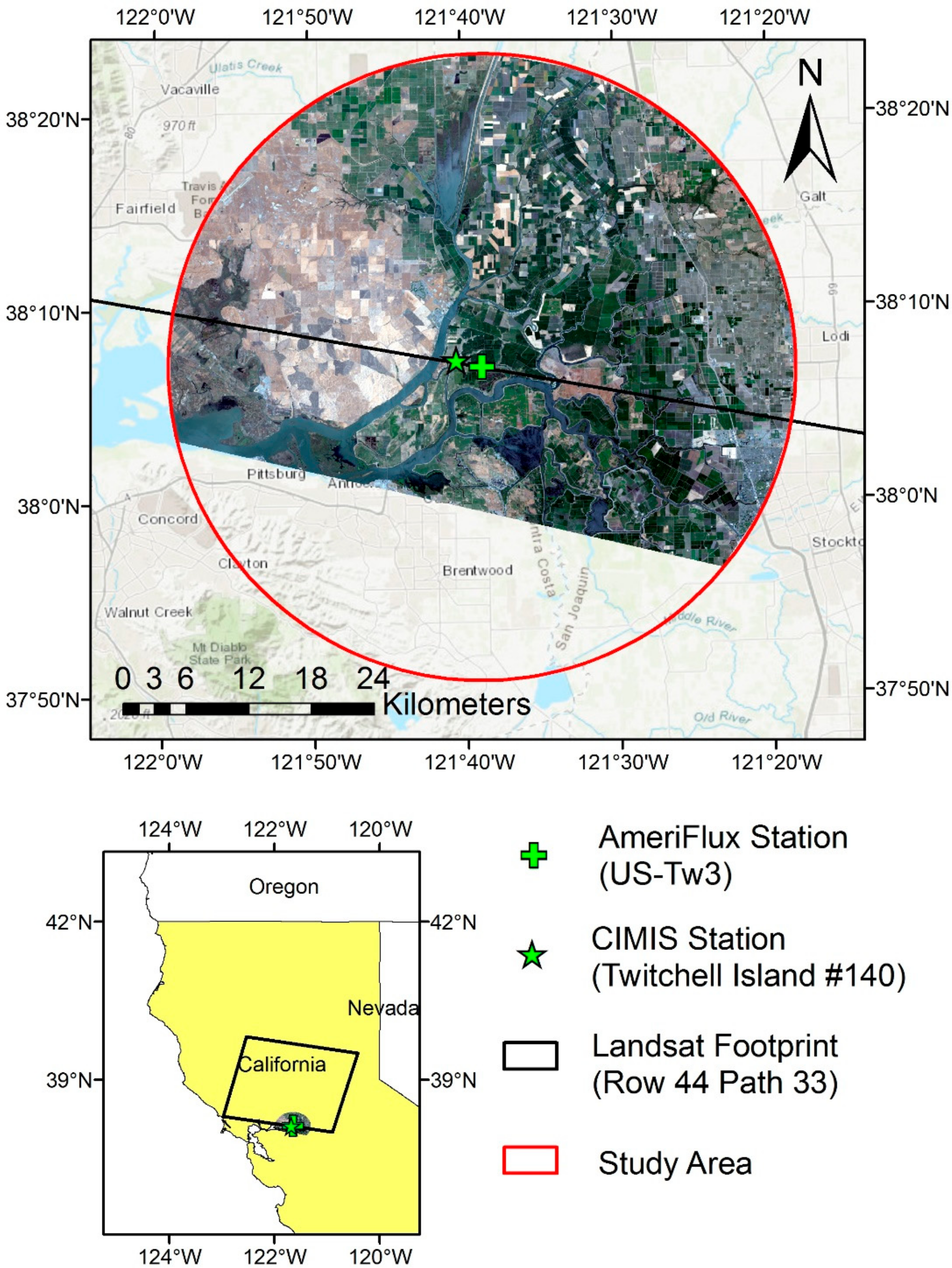
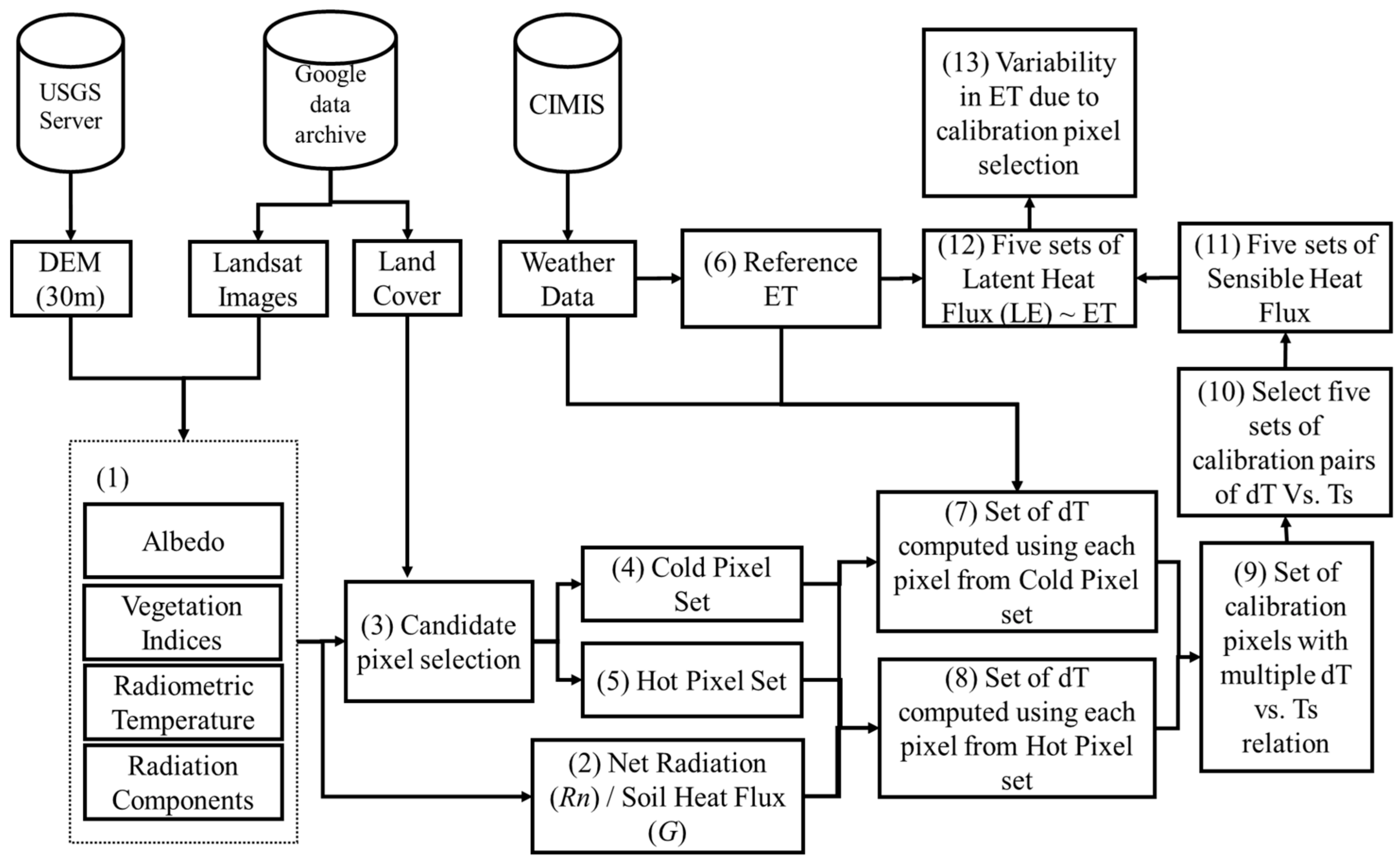
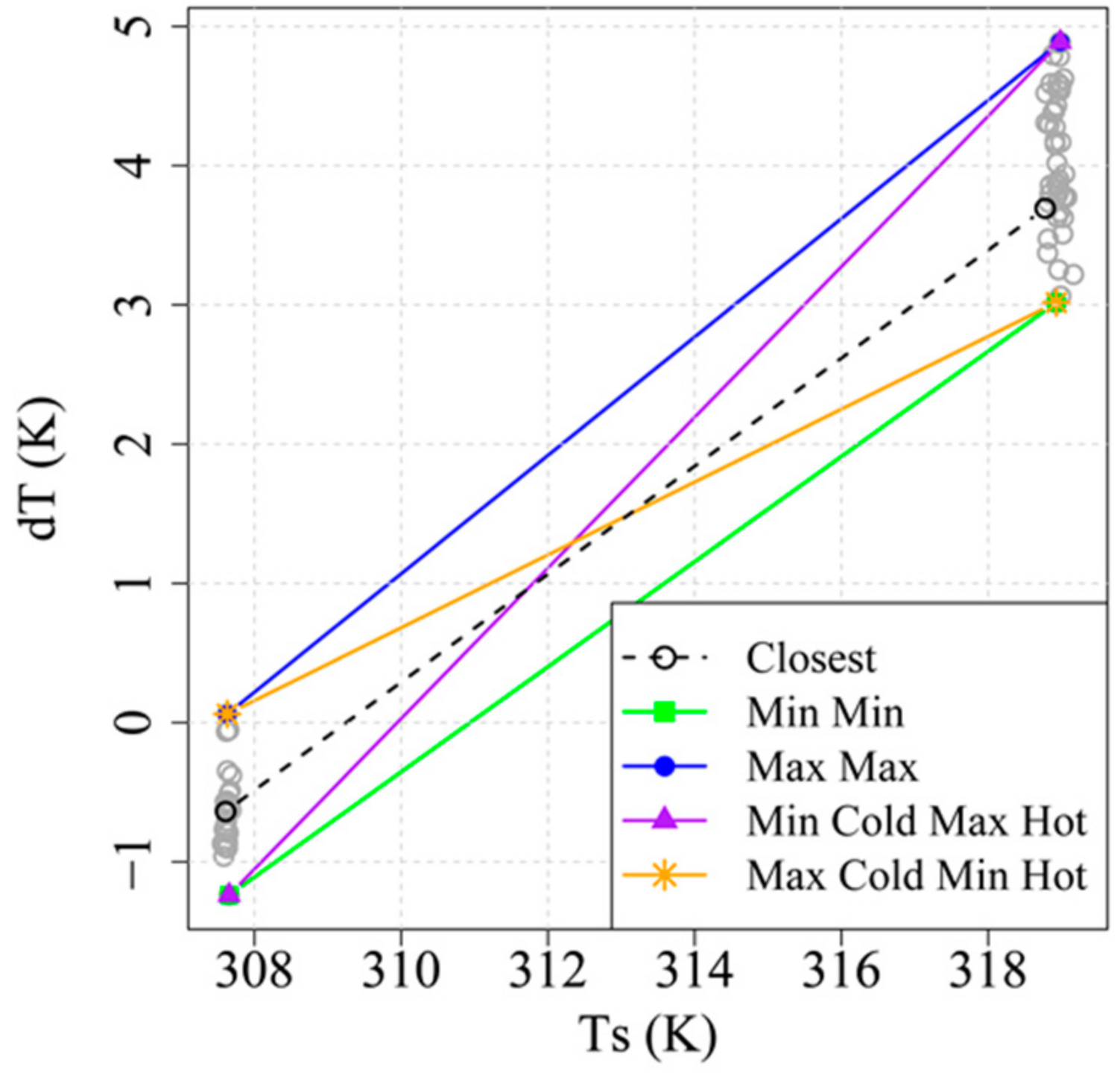

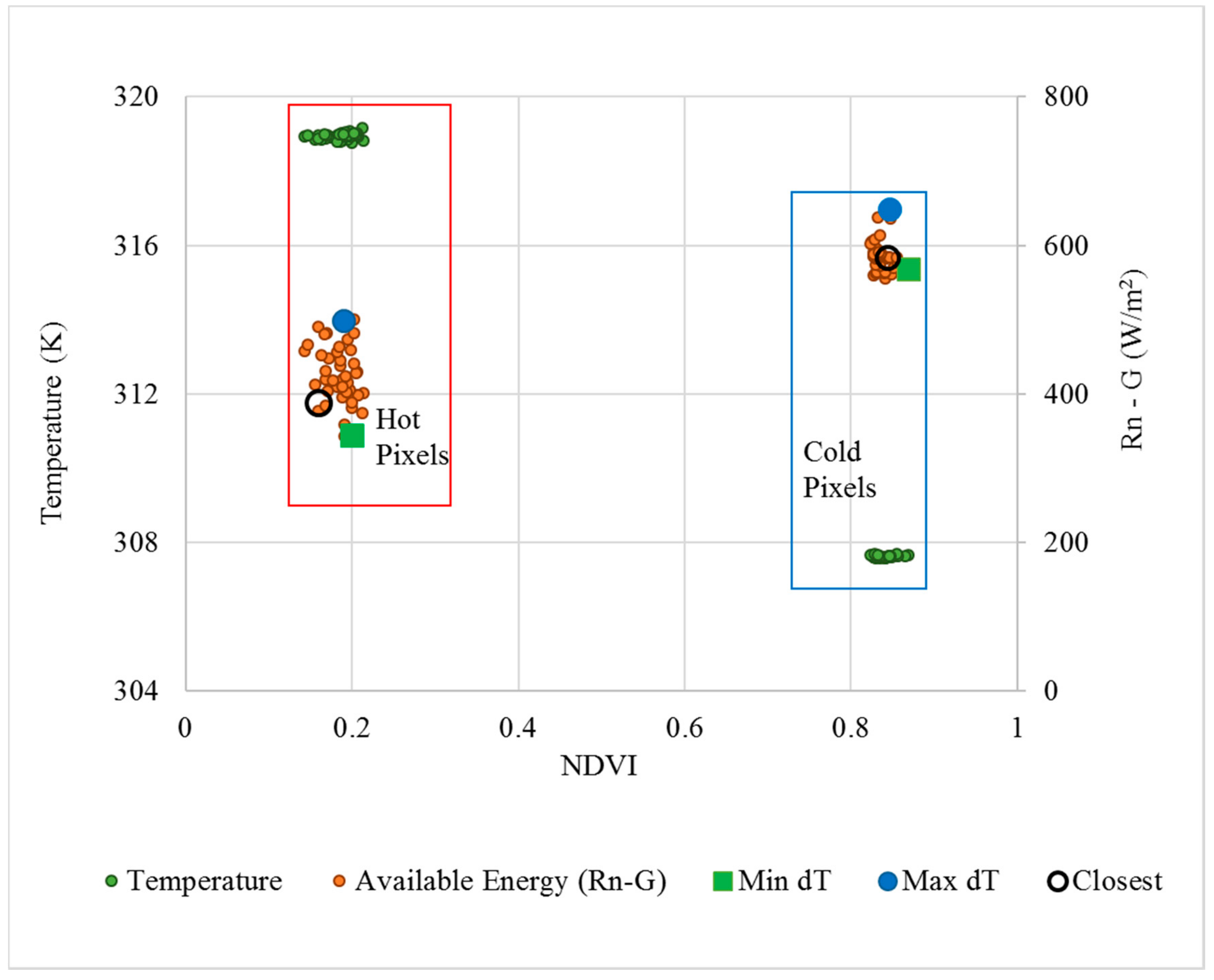

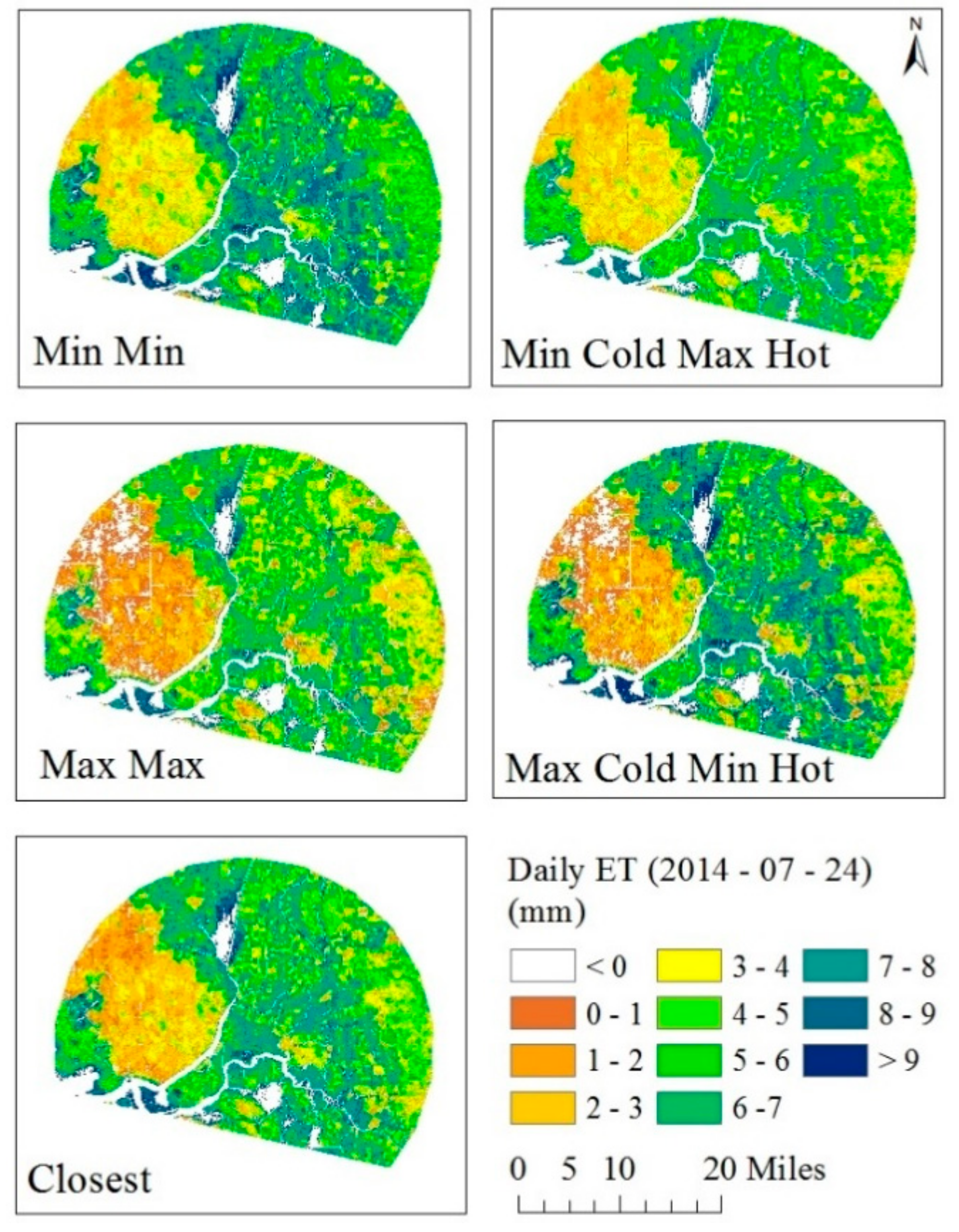
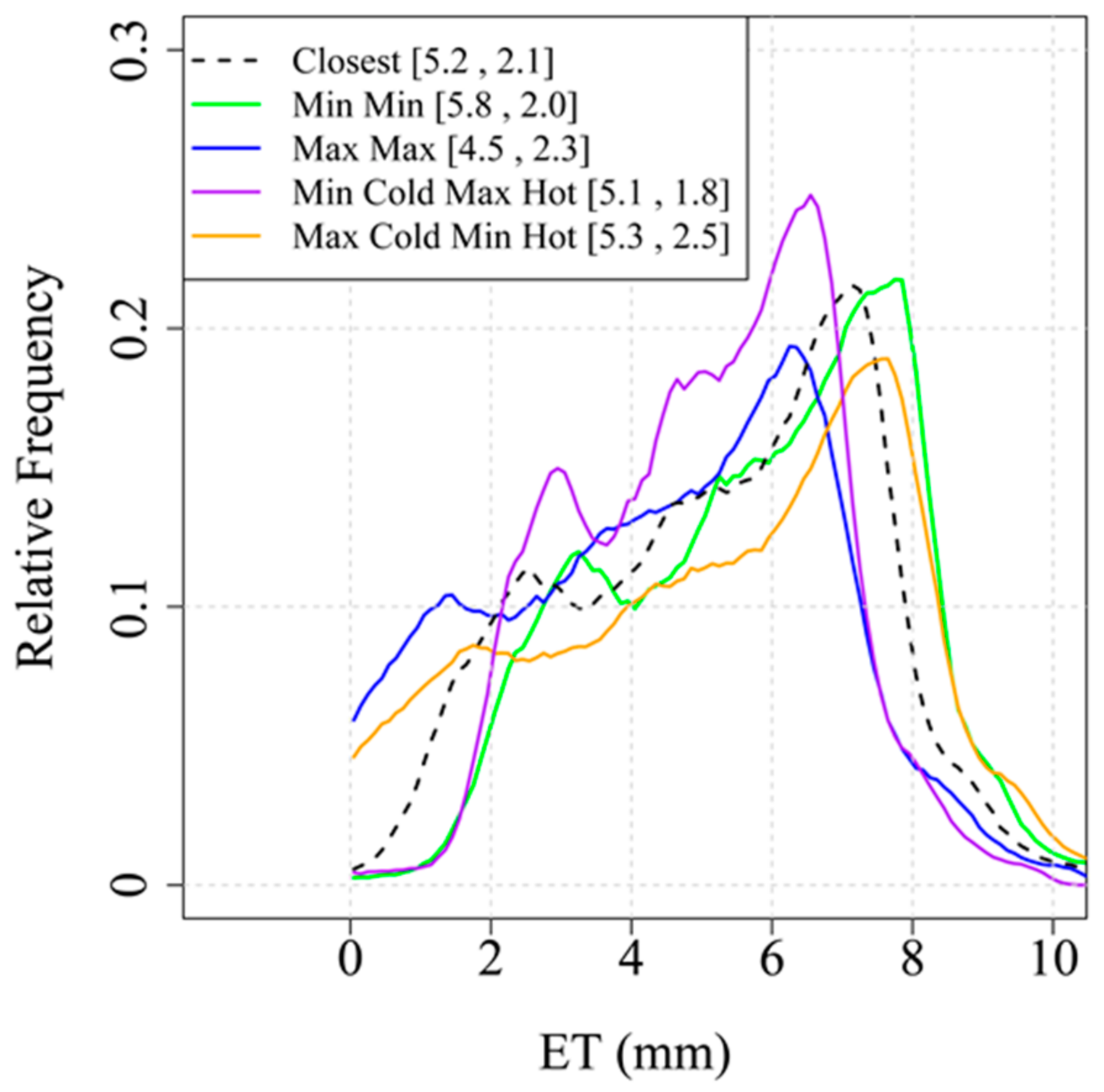
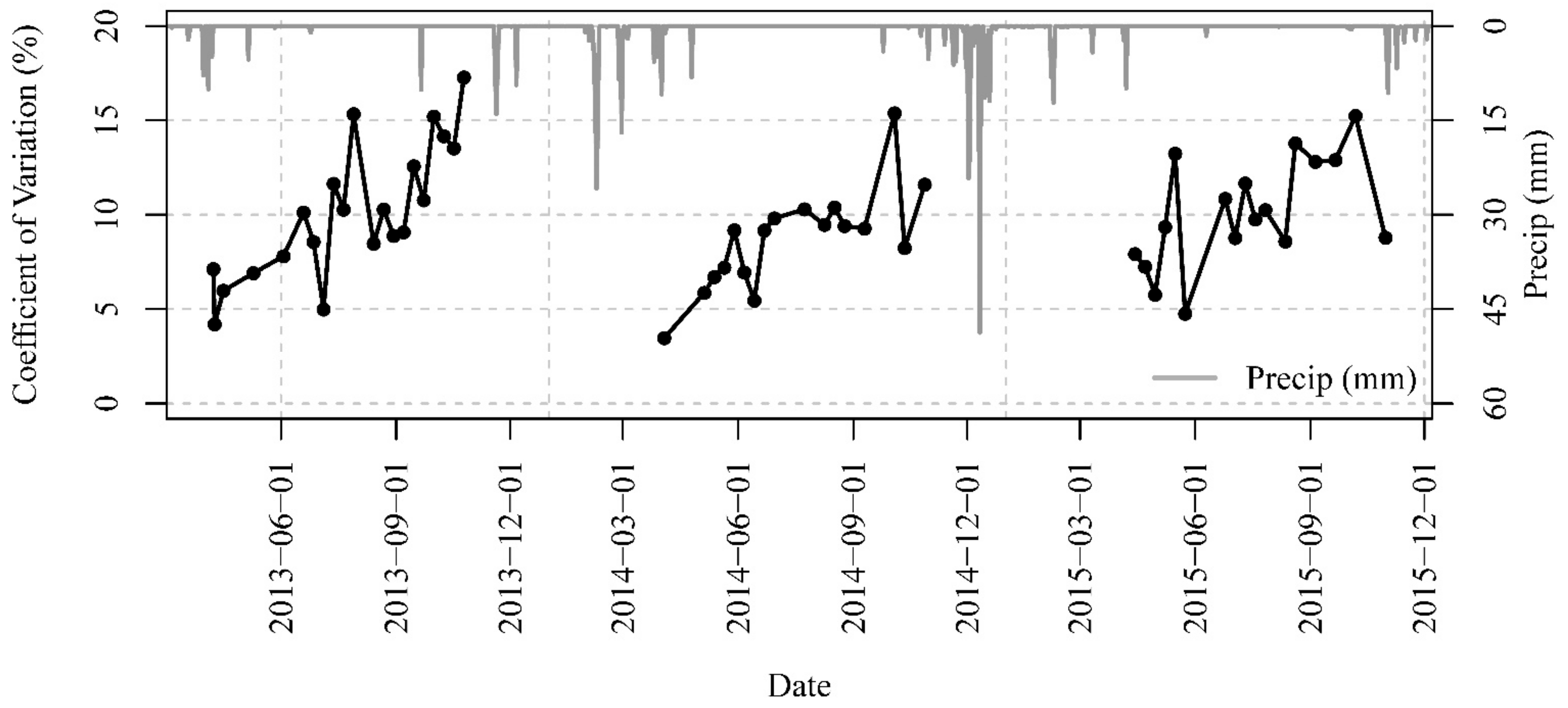
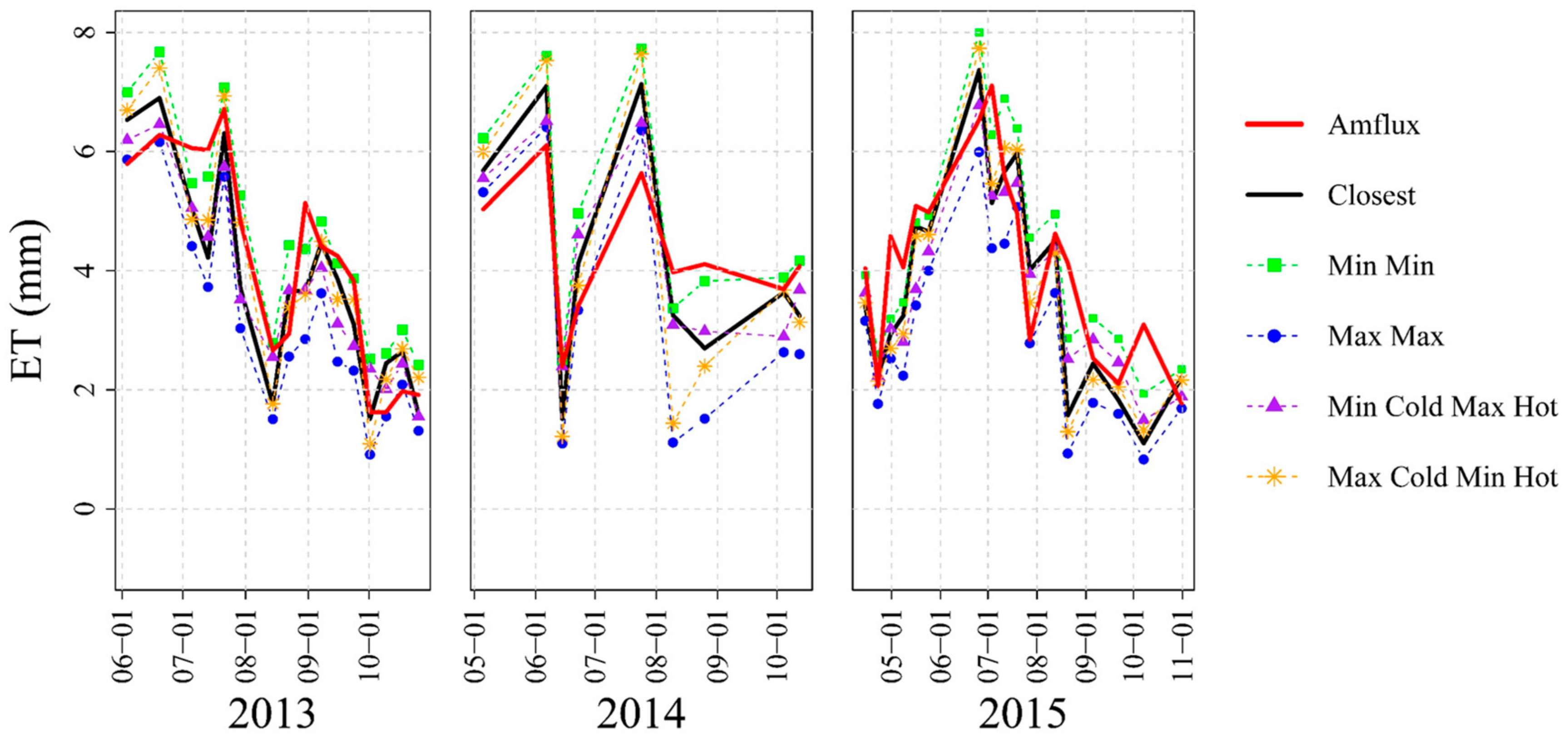
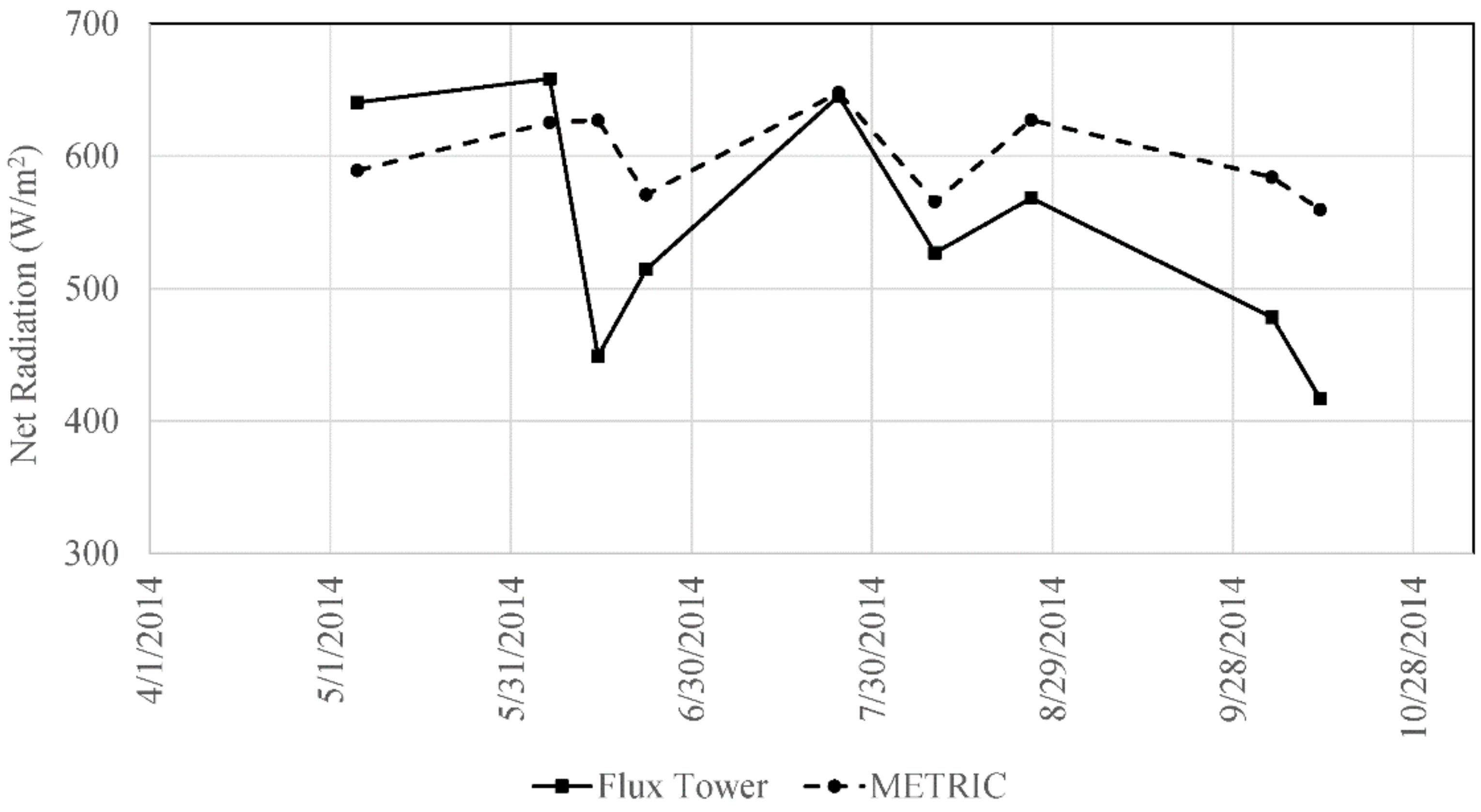
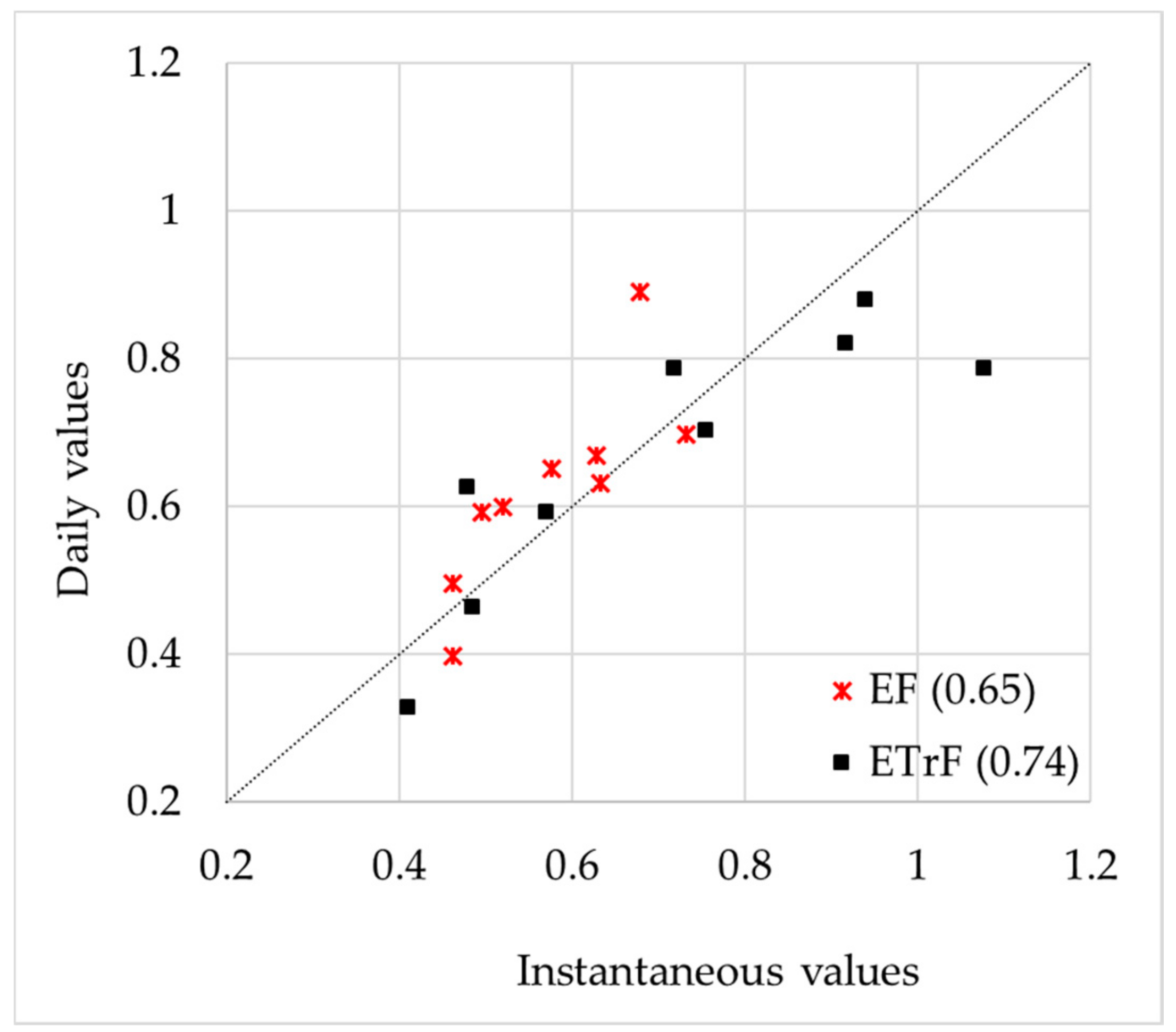

| Site Descriptors | Twitchell Island 140 | US-Tw3 |
|---|---|---|
| Latitude (N) | 38.1217 | 38.1159 |
| Longitude (W) | 121.6745 | 121.6467 |
| Elevation (m) | 0 | −9 |
| Cover type | Large Pasture | Alfalfa |
| Data availability period | 1998–current | 2013–2015 |
| Mean Annual temperature (°C) | 15 | 15 |
| Mean Annual precipitation (mm) | 382 | 421 |
| Temporal resolution provided at (min) | 60 | 30 |
| Source of data | CIMIS | Baldocchi 1 |
| YearMonthDay (YYYYMMDD) | Area Cloud Covered (%) | YearMonthDay (YYYYMMDD) | Area Cloud Covered (%) |
|---|---|---|---|
| 2013 | |||
| Landsat 7 | Landsat 8 | ||
| 20130713 | 2% | 20130603 | 5% |
| 20130729 | 4% | 20130619 | 4% |
| 20130814 | 2% | 20130705 | 7% |
| 20130830 | 3% | 20130721 | 7% |
| 20130915 | 3% | 20130822 | 7% |
| 20131001 | 2% | 20130907 | 7% |
| 20131017 | 3% | 20130923 | 7% |
| 20131009 | 7% | ||
| 20131025 | 8% | ||
| 2014 | |||
| Landsat 7 | Landsat 8 | ||
| 20140614 | 4% | 20140505 | 13% |
| 20141004 | 2% | 20140606 | 9% |
| 20140622 | 7% | ||
| 20140724 | 7% | ||
| 20140809 | 7% | ||
| 20140825 | 9% | ||
| 20141012 | 8% | ||
| 2015 | |||
| Landsat 7 | Landsat 8 | ||
| 20150414 | 2% | 20150422 | 8% |
| 20150430 | 2% | 20150508 | 12% |
| 20150516 | 3% | 20150524 | 8% |
| 20150703 | 4% | 20150625 | 8% |
| 20150719 | 5% | 20150711 | 7% |
| 20150820 | 2% | 20150727 | 7% |
| 20150905 | 2% | 20150812 | 7% |
| 20150921 | 3% | 20151031 | 8% |
| 20151007 | 3% | ||
| r2 | NSE | RMSE (mm) | Pbias (%) | |
|---|---|---|---|---|
| 2013 | ||||
| Closest | 0.78 | 0.75 | 0.87 | −4.0 |
| Min Min | 0.85 | 0.79 | 0.80 | 18.0 |
| Max Max | 0.80 | 0.47 | 1.28 | −25.0 |
| Min Cold Max Hot | 0.80 | 0.75 | 0.88 | −4.0 |
| Max Cold Min Hot | 0.82 | 0.79 | 0.79 | −1.0 |
| 2014 | ||||
| Closest | 0.83 | 0.18 | 0.95 | −7.0 |
| Min Min | 0.81 | 0.04 | 1.03 | 11.0 |
| Max Max | 0.72 | −1.13 | 1.54 | −29.0 |
| Min Cold Max Hot | 0.74 | 0.46 | 0.77 | −4.0 |
| Max Cold Min Hot | 0.77 | −0.82 | 1.42 | −14.0 |
| 2015 | ||||
| Closest | 0.62 | 0.44 | 1.13 | −9.0 |
| Min Min | 0.68 | 0.57 | 0.99 | 8.0 |
| Max Max | 0.63 | 0.01 | 1.50 | −28.0 |
| Min Cold Max Hot | 0.67 | 0.56 | 1.00 | −9.0 |
| Max Cold Min Hot | 0.65 | 0.41 | 1.16 | −10.0 |
| Name | Image Collection ID | Number of Bands |
|---|---|---|
| 1. USGS Landsat 7 Collection 1 Tier 1 Raw Scenes | LANDSAT/LE07/C01/T1 | 10 |
| 2. USGS Landsat 7 Collection 1 Tier 1 top-of-atmosphere (TOA) Reflectance | LANDSAT/LE07/C01/T1_TOA | 10 |
| 3. USGS Landsat 7 Surface Reflectance (SR) Tier 1 | LANDSAT/LE07/C01/T1_SR | 11 |
| 4. USGS Landsat 8 Collection 1 Tier 1 Raw Scenes | LANDSAT/LC08/C01/T1 | 12 |
| 5. USGS Landsat 8 Collection 1 Tier 1 top-of-atmosphere (TOA) Reflectance | LANDSAT/LC08/C01/T1_TOA | 12 |
| 6. USGS Landsat 8 Surface Reflectance Tier 1 | LANDSAT/LC08/C01/T1_SR | 12 |
| 7. USGS National Elevation Dataset 1/3 arc-second | USGS/NED | 1 |
| 8. NLCD: USGS National Land Cover Database | USGS/NLCD | 4 |
© 2018 by the authors. Licensee MDPI, Basel, Switzerland. This article is an open access article distributed under the terms and conditions of the Creative Commons Attribution (CC BY) license (http://creativecommons.org/licenses/by/4.0/).
Share and Cite
Dhungel, S.; Barber, M.E. Estimating Calibration Variability in Evapotranspiration Derived from a Satellite-Based Energy Balance Model. Remote Sens. 2018, 10, 1695. https://doi.org/10.3390/rs10111695
Dhungel S, Barber ME. Estimating Calibration Variability in Evapotranspiration Derived from a Satellite-Based Energy Balance Model. Remote Sensing. 2018; 10(11):1695. https://doi.org/10.3390/rs10111695
Chicago/Turabian StyleDhungel, Sulochan, and Michael E. Barber. 2018. "Estimating Calibration Variability in Evapotranspiration Derived from a Satellite-Based Energy Balance Model" Remote Sensing 10, no. 11: 1695. https://doi.org/10.3390/rs10111695



